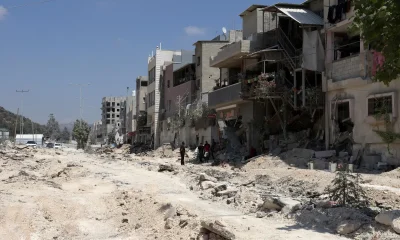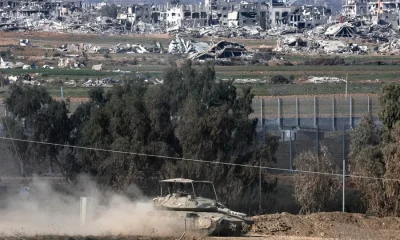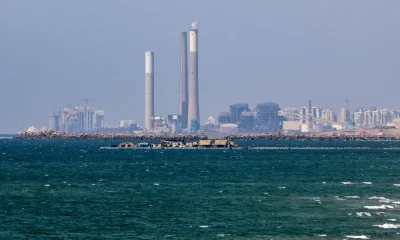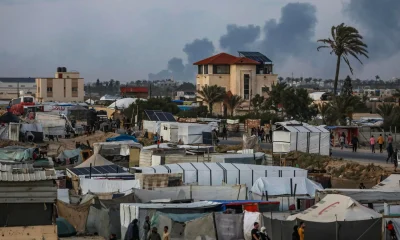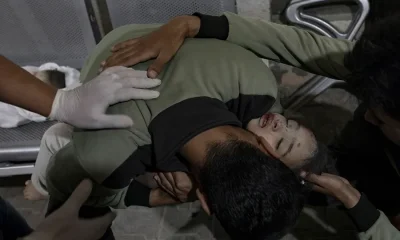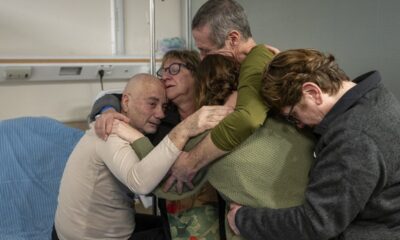International
Israel intensifies its offensive in Gaza and announces the death of three key figures in Hamas

Israeli troops intensified in the last hours the attacks and bombings against Gaza city, in addition to in the center and south of the Palestinian strip, and announced that they killed three key figures of Hamas in the al-Shifa Hospital, whose military siege lasts for the thirteenth consecutive day.
An operation coordinated by the Shayetet 13 flotilla, the Duvdevan unit and the Nahal brigade “carried out a selective raid on a hospital building (al Shifa) where they met the terrorists,” a military statement detailed today.
Always according to the text, the soldiers killed in the emergency room Mahmoud Halil Zakzouk, deputy commander of the rocket operations of Hamas, and in the maternity room Fadi Duyk, who helped carry out an attack in the West Bank in 2002, as well as Zakaria Najib, who had been convicted of participating in the kidnapping and murder of Israeli soldier Nachshon Wachsman in 1994.
These names are in addition to the death announced last Thursday of Raed Thabet, head of personnel and supplies of Hamas, also at the al Shifa Hospital. In total, according to Israeli military figures, more than 200 alleged militiamen have already been succumbed in this military operation, which began on March 18
In addition, about a thousand people have been arrested, and of them, about 500 would be associated with “Hamas or Palestinian Islamic Jihad,” according to Israel, which attacks this medical center for the fourth time.
Today, the Palestinian news agency Wafa denounced “executions, arrests, torture and forced displacements” in the center, as the European-Mediterranean Human Rights Monitor already did on Wednesday, after documenting the “execution” of thirteen children – between 4 and 16 years old – by direct Israeli fire against the medical complex.
Since the beginning of the war in Gaza, almost six months ago, more than 32,700 Gazans have died and about 75,200 have been injured, more than 72% women and children, according to today’s figures from the Ministry of Health of the Government of Hamas. Another 8,000 bodies are estimated to remain under tons of debris.
Despite the destruction, the United States authorized in recent days the transfer of billions of dollars in bombs and fighter jets to Israel, according to military and diplomatic sources. A movement criticized today by the Palestinian Foreign Ministry, which says it questions the alleged US concern about the high number of civilian deaths in the enclave.
“Requesting (Prime Minister Benjamin) Netanyahu to stop killing civilians and supplying him (at the same time) with weapons is an unprecedented moral and principled contradiction,” the ministry said in a statement on social network X.
The ministry also regretted the “continuous failure” by the UN Security Council and the International Court of Justice (ICJ) to force Israel to respect its decisions, including the implementation of a ceasefire in Gaza and allowing more aid to enter the enclave.
This week, the UN Security Council approved a resolution for a ceasefire, thanks to the abstention of the United States. The ICJ issued new provisional measures as part of the case initiated by South Africa for incitement to genocide, and demanded the Netanyahu government for the immediate, large-scale and unrestricted entry of aid in Gaza.
More than one million Gazans suffer from a lack of food of catastrophic proportions, according to a recent UN-backed food insecurity report, and famine is already imminent for more than 200,000 people in the northern Strip.
However, nothing has changed despite those international mandates, and only 159 trucks on average per day have managed to enter Gaza this March with humanitarian aid, according to UNRWA data, compared to the half a thousand that did it before the war
In Israel, thousands of people demonstrated tonight in the already known as the hostage square, in Tel Aviv, demanding an agreement from the Israeli Prime Minister, Benjamin Netanyahu, for the release of the 134 hostages that remain in the hands of Hamas since the attack on October 7.
A parallel protest, also in the area of Kaplan and Begin streets, where the Ministry of Defense is located, demanded today the end of Netanyahu’s Government and early elections.
“It’s been) 176 days, 4,224 hours,” Shira Elbag, mother of the hostage Liri Elbag, said at the demonstration. “I hear Liri screaming! Mom, save me. Mom, it’s hurting me! 176 days (and) 4,224 hours in which I haven’t kept an eye due to the thoughts and fear of what Liri and the other hostages are living,” he added.
Negotiations for a truce in Gaza and the release of hostages are expected to resume tomorrow in Cairo, as reported today by the Egyptian channel Al Qahera News TV, citing a security source. Yesterday, Netanyahu’s Office announced that it had approved the sending of an Israeli delegation in the coming days.
International
Dominican ‘False Hero’ Arrested for Faking Role in Nightclub Collapse That Killed 231

A man identified as Rafael Rosario Mota falsely claimed to have rescued 12 people from the collapse of the Jet Set nightclub in Santo Domingo—a tragedy that left 231 people dead—but he was never at the scene.
Intelligence agents in the Dominican Republic arrested the 32-year-old man for pretending to be a hero who saved lives during the catastrophic incident, authorities announced.
Rosario Mota had been charging for media interviews in which he falsely claimed to have pulled survivors from the rubble after the nightclub’s roof collapsed in the early hours of April 8, during a concert by merengue singer Rubby Pérez, who was among those killed.
“He was never at the scene of the tragedy,” the police stated. The arrest took place just after he finished another interview on a digital platform, where he repeated his fabricated story in exchange for money as part of a “media tour” filled with manipulated information and invented testimonies.
“False hero!” read a message shared on the police force’s Instagram account alongside a short video of the suspect, in which he apologized: “I did it because I was paid. I ask forgiveness from the public and the authorities.”
Central America
Nicaraguan Exiles to Mark 7th Anniversary of 2018 Protests with Global Commemorations

The Nicaraguan opposition in exile announced on Thursday that it will commemorate the seventh anniversary of the April 2018 protests against the government of President Daniel Ortega and his wife, Rosario Murillo, with events in Costa Rica, the United States, and several European countries.
The commemorative activities—which will call for justice for the victims, as well as freedom and democracy for Nicaragua—will include religious services, public forums, cultural fairs, and other public gatherings, according to official announcements.
In April 2018, thousands of Nicaraguans took to the streets to protest controversial reforms to the social security system. The government’s violent response quickly turned the demonstrations into a broader call for the resignation of President Ortega, who is now 79 and has been in power since 2007.
The protests resulted in at least 355 deaths, according to the Inter-American Commission on Human Rights (IACHR), although Nicaraguan organizations claim the toll is as high as 684. Ortega has acknowledged “more than 300” deaths and maintains the unrest was an attempted coup d’état.
International
Arsenal stun Real Madrid at the Bernabéu to reach Champions League semifinals

Arsenal enjoyed a “historic night” on Wednesday after defeating Real Madrid 2-1 at the Santiago Bernabéu, knocking them out of the Champions League quarterfinals, midfielder Declan Rice said.
“It’s such a special night for this club, a historic night for this club,” said Rice, who scored twice in the first leg in London, speaking to TNT Sports.
The English international was named Man of the Match in both legs — the 3-0 win in London and the second leg in Madrid.
“It’s amazing. I knew we were on an upward trajectory and we’ve done incredibly well in this competition. We deserve it and we have full confidence in our coach. Reaching the semifinals is unbelievable,” Rice added.
-

 Central America4 days ago
Central America4 days agoHonduran Police Offer $135K for Tips Leading to the Arrest of Romeo Vásquez
-

 Central America3 days ago
Central America3 days agoPetro questions Ecuador’s vote, cites reports of military control and arrests
-

 International4 days ago
International4 days agoMPV Denounces Electoral Blockade as Secretary-General is Disqualified for May Elections
-

 International2 days ago
International2 days agoArsenal stun Real Madrid at the Bernabéu to reach Champions League semifinals
-

 International4 days ago
International4 days agoMaduro Plans Major Workers’ March on May 1st to Defend Venezuela’s Freedom
-
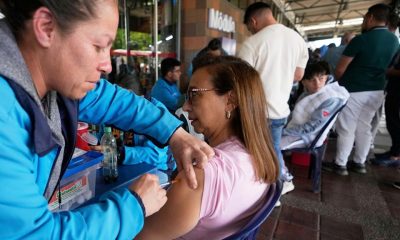
 International2 days ago
International2 days agoBogotá residents line up for yellow fever vaccine amid national alert
-

 International2 days ago
International2 days agoMexico refuses to restore ties with Ecuador while Noboa remains in office
-

 International2 days ago
International2 days agoDeSantis’ immigration crackdown sparks alarm in Venezuelan Communities in Doral
-

 International18 hours ago
International18 hours agoDominican ‘False Hero’ Arrested for Faking Role in Nightclub Collapse That Killed 231
-

 Central America18 hours ago
Central America18 hours agoNicaraguan Exiles to Mark 7th Anniversary of 2018 Protests with Global Commemorations
-

 International3 days ago
International3 days agoColombia: Search continues for missing limb of italian scientist found dismembered
















